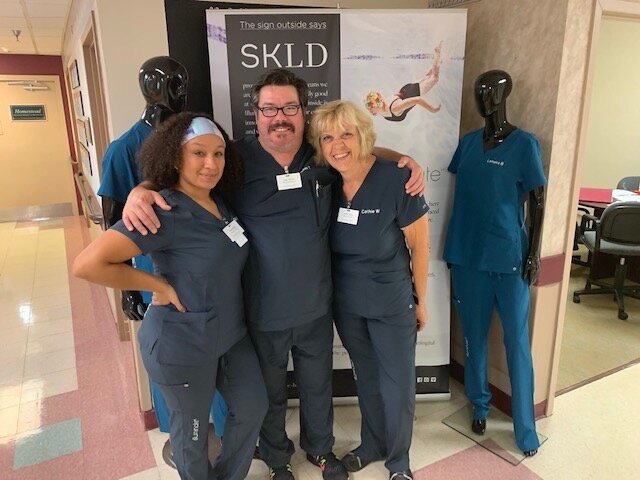Wound care in Perrysburg skilled nursing facility provides crucial treatment to patients
Seventeen years ago SKLD Perrysburg resident Anthony Taylor was a teenage victim of a car crash that nearly killed him and left him with a series of debilitating wounds he’s battled ever since.
Today, after nine months at our skilled nursing facility in Perrysburg, Ohio, most of those wounds are healed, according to Cathie Weiss, the facility’s wound care nurse.
SKLD Perrysburg is the only skilled nursing facility in the area known to have a full-time wound care nurse and a robust wound care team with deep training.
Anthony, or “Tony,” agreed to share his story in hopes that he can help others who live with wounds that won't heal.
Wound care patient is healed after 17 years
According to wound care nurse, Cathie, Tony came to SKLD after an infection left him in the hospital, and leading him to seek alternate placement. Reading over his referral made it obvious why everyone was challenged by this patient. He had wounds for years, and his physician said they would never heal. He was on dialysis, had respiratory failure, a colostomy and lost a limb. “Anything that could go wrong had happened to Tony,” says Cathie.
But Cathie and SKLD Perrysburg’s Administrator Craig Sunday saw Tony’s chart and said resolutely, “We’re taking him.”
Tony came to SKLD eager to do whatever it takes to heal. “We healed four of his wounds within a few weeks and the rest of the wounds are about nearly all healed,” says Cathie. “He’s come so far and is so excited and passionate about his healing process.”
Tony’s doctor can’t believe how far he’s come in his healing, but Cathie can. She sees the power of proper wound care treatment every day in her work as a skilled nursing wound care nurse over the past 13 years. It’s what keeps her passionate about this area of long term nursing care.
Tony gives full credit to Cathie for his remarkable feat of healing. He likes to call her the “The Wound Whisperer” and believes that Cathie can help others in the same situation. Tony has lived with these wounds since he was 19, and this is the first time his wounds have been healed this well. He calls it "a miraculous healing of unhealable wounds.”
"Being at SKLD Perrysburg has been a blessing, and working with Cathie has been an amazing experience,” says Tony.
Wound care nurse Cathie Weiss (right) is pictured with colleagues Tanya Ridley and John Tercha at SKLD Perrsyburg. Note, this photo was taken before the pandemic.
Why wound care is important in skilled nursing facilities
Wound care is essential to the work that skilled nursing facility teams do for patients because of the positive impact it can make on patients’ lives. Proper wound care aides in the prevention of infection and other complications and also helps speed up the healing process. Treating wounds allows patients to move beyond their pain to focus on other areas of progress in their health.
“If a patient hurts, they don’t want to participate in therapy. First, you have to get the pain under control, then you can focus on wound care, and only then can you focus on the rehab,” says Cathie.
Why Cathie is so passionate about being a wound care nurse
Cathie has been a nurse for over 30 years and a wound care nurse for 13 years. She was always interested in this area of skilled nursing care but says she learned little about wound care in school. Instead, she worked under the direction of Dr. Mark Nadaud, a local physician devoted to wound care, who worked in wound care at local hospitals in Oregon, Ohio. Under his careful guidance, Cathie spent hours treating wounds, learning from him and visiting wound care centers as she accompanied patients to appointments.
Since then, she’s gravitated toward every learning opportunity to expand her knowledge and improve her treatment of wounds by taking courses online and attending wound care seminars. What motivates Cathie is the significant impact she is able to make on skilled nursing patients, who often tend to be younger. “We are able to see the progress we can make and the impact we have on improving their quality of life. We rid patients of infection, and then we get to see them return home.”
Wound care supports patients with a variety of health issues
In contrast to other skilled nursing areas, wound care patients tend to be younger and in many cases can return home once they are successfully treated. Cathie often works with patients who have some of the following of health issues, but her knowledge of wound care can also proactively prevent all patients from needing treatment once a wound begins to fester.
Aggressive surgical procedures
Bariatric surgery
Diabetic ulcers
Cancer complications related to different diseases
Vascular wounds
Severe burns
Her work means that she is able to support patients who suffer tremendously move beyond their pain to address other areas of rehabilitation and healing. “I’m so motivated by the patient outcomes we see in wound care and how important this is to them and their families.” I’ve seen patients who can’t wear shoes because of wounds, and we are able to help them with the healing process, getting to a point they can stand up again, walk and wear appropriate footwear.“
Educating the whole skilled nursing team supports better wound care treatment
Cathie spends time every day educating her whole SKLD Perrysburg team about preventative measures and proper treatment of wounds. Their support and knowledge have been crucial to the whole facility’s efforts to provide the best wound care support in the Perrysburg area. STNAs who come to Cathie after identifying a patient’s skin area that looks questionable receive ready accolades and high fives from Cathie. Their effort as a team means their patients have areas identified, resolved quickly.
The SKLD Perrysburg team uses a three-step approach to wound care
Proactive wound identification: When the entire team is educated about signs of irritated skin, wounds can be proactively addressed before the skin becomes further damaged. STNAs and nurses at SKLD Perrysburg are all trained to look for alterations in the skin and report as soon as it appears. Patients with a low Braden score on their admissions skin evaluation are put on a high protein diet by the facility dietitian. And there is no shortage of air mattresses as well as adaptive devices warranted for those patients who can benefit from them.
Preventing Infection: Once a wound occurs, it’s essential to continually attend to the wound to reduce the risk for infection and other complications. Nursing staff trained in proper wound care can determine the best medical course of action as well, following the plan of care, noting the wound’s progress or developments.
Expediting Healing: Proper treatment and interventions of wounds can lead to faster healing and decrease the chance of infection and complications. SKLD Perrysburg teams are all trained in areas to promote wound care.
What long term care patients can do to support faster wound care healing
Once a wound develops, the faster the healing, the less likely the chance of infection.
Cathie attributes some of Tony’s progress to his positive attitude and willingness to do what it takes to heal his wounds. Although she admits the SKLD Perrysburg team can still support patients who are less compliant, those patients who stay positive and motivated to heal can see progress faster.
Following are just some of the ways a wound care patients can support their healing
Accept care
Assure adequate consumption of proteins each day
Rotate positions in bed, including turning on one’s side
Offloading as warranted
Commit to proper hygiene
Agree to change linen
Limitations for activity as per plan of care
Thanks to the patient’s commitment to heal, Cathie’s wound care knowledge and the SKLD Perrysburg team’s dedication, Tony has never felt so well in 17 years.
Click here to find out about patient placement and other services at SKLD Perrysburg or any of our facilities across Ohio and Michigan.

